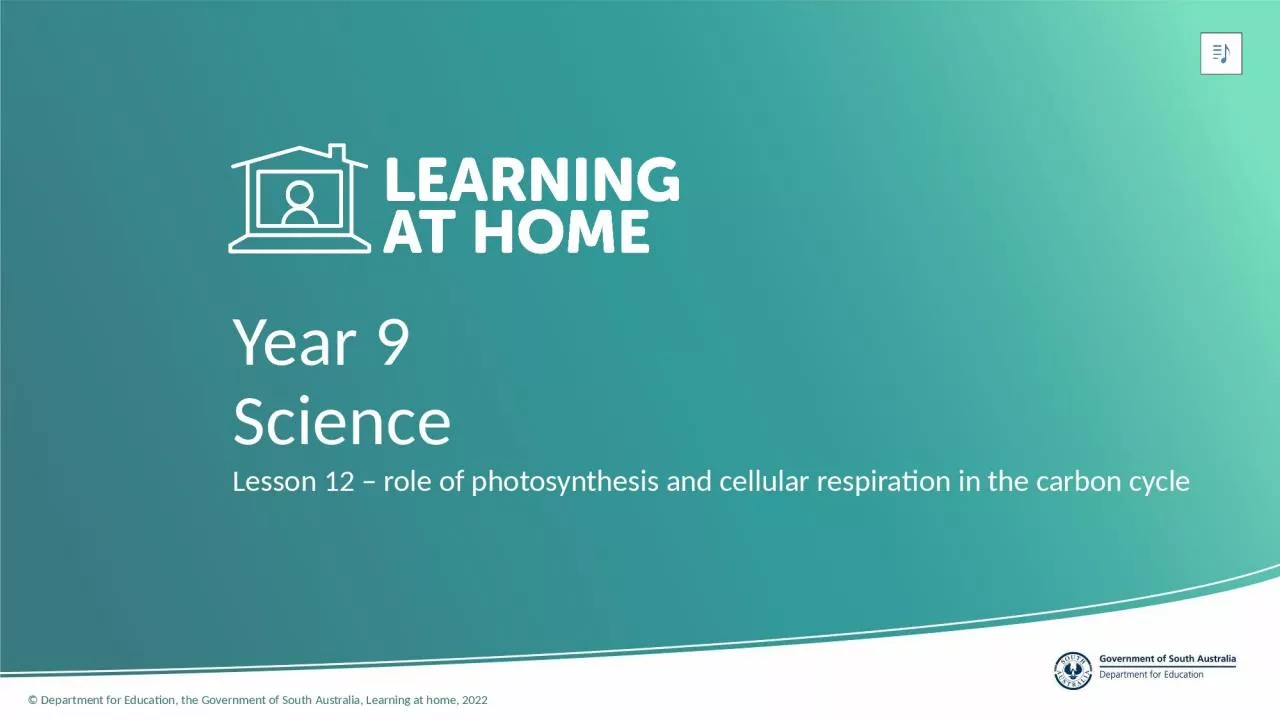

Science Lesson 11 challenge answer Find out the importance of carbon dioxide in the atmosphere Carbon dioxide traps heat in the atmosphere which is needed for our earth to be habitable Otherwise earth would be a frozen world ID: 1041543
Download Presentation The PPT/PDF document "Year 9 Lesson 12 – role of photosynthe..." is the property of its rightful owner. Permission is granted to download and print the materials on this web site for personal, non-commercial use only, and to display it on your personal computer provided you do not modify the materials and that you retain all copyright notices contained in the materials. By downloading content from our website, you accept the terms of this agreement.
1. Year 9Lesson 12 – role of photosynthesis and cellular respiration in the carbon cycleScience
2.
3. Lesson 11: challenge answer Find out the importance of carbon dioxide in the atmosphere. Carbon dioxide traps heat in the atmosphere which is needed for our earth to be habitable. Otherwise, earth would be a frozen world. On another note, we have burned too many fossil fuels that there is so much carbon dioxide in the earth, that the earth is becoming a warmer place and ice in polar regions is melting.
4. Learning intention To understand the link between photosynthesis, cellular respiration and the carbon cycle.
5. You will needA pen and paper.A digital device.
6. Key termsPhotosynthesis – chemical reaction that occurs in plants to convert sunlight into stored chemical energy in the form of glucose.Cellular respiration – chemical process that animals and plants use to release energy stored in food (sugar). Fossil fuels – fuel that has been formed from the remains of living things.Decomposition – process in which matter from dead organisms is broken down. Also called rotting.Carbon – an element in the periodic table.Carbon cycle – cycle of carbon through nature.
7. Photosynthesis and cellular respiration
8. The carbon cycle
9. The carbon cycle and photosynthesisDuring photosynthesis, plants absorb carbon dioxide and turn this into glucose and oxygen. Animals and humans can use this glucose to respire. Plants use the glucose to grow. If a plant dies without being consumed, it decays and returns the carbon to the soil. The carbon cycle would not be possible without photosynthesis as plants ‘start’ the cycle.
10. QuestionDeforestation is the removal of large amounts of plants and trees. What is the impact of deforestation on the atmosphere in terms of carbon? The answer is on the following slide.
11. AnswerDeforestation is the removal of large amounts of plants and trees. What is the impact of deforestation on the atmosphere in terms of carbon? Deforestation increases carbon dioxide in the atmosphere. This leads to increased temperatures. This is because there are less plants and trees to take in the carbon dioxide and turn it into oxygen through photosynthesis.
12. Cellular respiration and the carbon cycleAnimals (and plants) are responsible for returning the carbon back to the atmosphere through cellular respiration. They obtain the carbon from plants which have photosynthesised. Animals have also gained carbon from eating other animals. Bacteria and fungi which are decomposers also return carbon back to the atmosphere though cellular respiration as they feed on dead animals and plants.
13. QuestionDecomposers (bacteria and fungi) return carbon back to the atmosphere by decomposing dead matter. This is through cellular respiration. Some areas on earth can speed up decomposition. What are the areas of earth that speed up decomposition?
14. AnswerDecomposers return carbon back to the atmosphere by decomposing dead matter. This is through cellular respiration. Some areas on earth can speed up decomposition. Find out what they are. Temperature plays a role in decomposition, so generally warmer and more moist areas mean that decomposition occurs quicker. Therefore, areas closer to the equator, such as tropical rainforests are quicker at decomposing (and therefore returning carbon to the atmosphere), than colder areas like the arctic regions.
15. Fill in the blanksAnimals and human respire and release carbon dioxide.Animals and humans eat plants (and other animals) and the carbon is transferred to them.Bacteria and fungi and other decomposers respire and release carbon to the atmosphere.Plants take in carbon from the atmosphere and photosynthesise with it.
16. AnswersAnimals and humans respire and release carbon dioxide.Animals and humans eat plants (and other animals) and the carbon is transferred to them.Bacteria and fungi and other decomposers respire and release carbon to the atmosphere.Plants take in carbon from the atmosphere and photosynthesise with it.
17. VideoDecomposers decompose the carbon from dead plants and animals. Dead plants and animals are often called detritus, which is where the carbon accumulates. View the video and make notes on the importance of detritus in food chains. Describe how humans sometimes eat detritus. The answer is on the next slide. Source: Dead stuff: the secret ingredient in our food chain on YouTube (John C. Moore, 2014)For your safety, watch this video in the slideshow without accessing YouTube
18. AnswerDescribe how humans sometimes eat detritus. Human beings eat plants directly and sometimes we eat animals who have eaten plants. Plants feed on the detritus and we feed on the plants. Therefore, we as humans indirectly eat the detritus.
19. SummaryPhotosynthesis and cellular respiration play an important role in the carbon cycle.The carbon cycle represents the cycle of carbon through nature. Without photosynthesis, the carbon cycle would not be able to ‘start’.Decomposers such as bacteria and fungi also respire and contribute to the carbon cycle.
20. ChallengeFind out how oceans release carbon dioxide into the atmosphere. The answer will be in the next lesson.
21.
22.